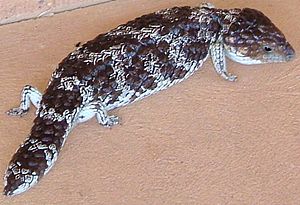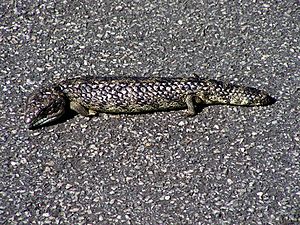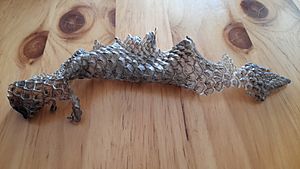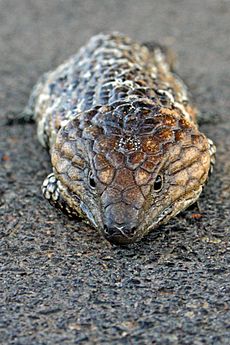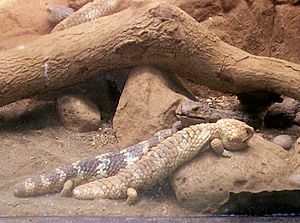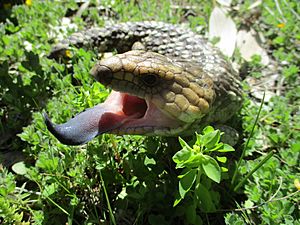Tiliqua rugosa facts for kids
Quick facts for kids Tiliqua rugosa |
|
|---|---|
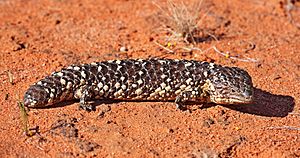 |
|
| Eastern shingleback | |
| Conservation status | |
| Scientific classification | |
| Genus: |
Tiliqua
|
| Species: |
rugosa
|
| Subspecies | |
|
|
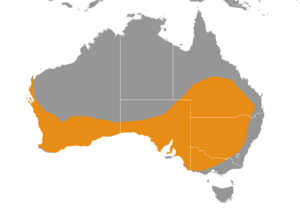 |
|
| Distribution of Tiliqua rugosa | |
| Synonyms | |
|
Trachydosaurus rugosus |
|
The shingleback skink (Tiliqua rugosa) is a unique lizard from Australia. It's also known as the bobtail lizard or sleepy lizard. This skink is a type of blue-tongued skink, known for its short, wide tail.
People in different parts of Australia call it by other names too. These include "two-headed skink," "stumpy-tailed skink," "bogeye," or "pinecone lizard." The Noongar Aboriginal people call it yoorn.
The shingleback skink has a short, thick tail that looks a bit like its head. This might confuse animals that want to eat it. The tail also stores fat, which helps the skink survive winter. During winter, they slow down a lot, like hibernating, but still need water.
This skink eats both plants and small animals. It's an omnivore. It often eats snails and various plants. You might see them warming up in the sun on roadsides or other paved areas.
Contents
- About the Shingleback Skink's Name
- Types of Shingleback Skinks
- Where Shingleback Skinks Live
- What Shingleback Skinks Look Like
- What Shingleback Skinks Eat
- Shingleback Skink Behavior
- Who Eats Shingleback Skinks?
- Shingleback Skink Reproduction
- How Shingleback Skinks Socialize
- Shingleback Skink Senses
- Conservation Status
- See also
About the Shingleback Skink's Name
The shingleback skink was first described in 1825 by John Edward Gray. He called it Trachydosaurus rugosus. Today, its scientific name is Tiliqua rugosa. Some scientists say this lizard has more common names than any other lizard!
Types of Shingleback Skinks
There are four main types, or subspecies, of the shingleback skink:
- Tiliqua rugosa asper: This is the eastern shingleback, found in eastern Australia.
- T. rugosa rugosa: This is the bobtail or western shingleback, found in Western Australia.
- T. rugosa konowi: This one is called the Rottnest Island bobtail. It lives only on Rottnest Island in Western Australia.
- T. rugosa palarra: This is the northern bobtail, found near Shark Bay in Western Australia.
Where Shingleback Skinks Live
These skinks live in dry and semi-dry areas of southern and western Australia. You can find them from Shark Bay, Western Australia, all the way across to Queensland.
They live in places like shrub lands, eucalyptus forests, desert grasslands, and sandy dunes. They often hide under low plants. Since they are cold-blooded, they love to bask in the sun in open spots. This is why you often see them on roadsides.
Each skink usually has a home area about the size of four football fields. They can travel up to 500 meters in a day. They often use the same burrows for many years. Sometimes, several skinks might even share a burrow, especially when it's hot and dry.
What Shingleback Skinks Look Like
The shingleback skink has a tough, armored body. Their color can be dark brown to cream. They are quite heavy for their size, growing up to 31 centimeters (about 12 inches) long. Their eyes are small and reddish-brown or grey.
They have a triangular head and a bright blue tongue inside a bright pink mouth. Their short, thick tail looks like their head. This might help them trick predators. The tail also stores fat. Unlike many lizards, shinglebacks cannot drop their tails if a predator grabs them.
Shingleback skinks usually live for 10 to 15 years. Some have even lived for up to 50 years in the wild!
These skinks shed their skin all at once, even the skin over their eyes. This can take several hours. They rub against things to help the old skin come off.
Male shinglebacks are usually stockier and have bigger heads than females. Females often grow a bit larger overall.
What Shingleback Skinks Eat
Shingleback skinks are omnivores. This means they eat both plants and animals. They enjoy snails, insects, dead animals (carrion), plants, and flowers. Since they move slowly, they tend to eat other slow-moving things. They can easily crush snail shells with their strong jaws.
When they live near people, they might also eat human food. They have been known to eat things like sausage, chicken, strawberries, bananas, and passionfruit.
Shingleback Skink Behavior
Shingleback skinks generally live a quiet life. They are usually peaceful with other skinks. However, they can be protective of their home areas. They might fight with other skinks they don't know.
They can tell other skinks apart by their smell. Skinks that are family and share burrows usually don't fight. But unfamiliar males might fight each other.
Male shinglebacks sometimes wander into other skinks' home areas. Shingleback parents do not take care of their babies for very long. But the male and female often stay together before mating.
Shinglebacks as Pets
Shingleback skinks are popular pets in Australia. They are usually calm and easy to feed. You might need a special permit to keep them in some places. If a shingleback feels threatened, it might bite. Their bites are not poisonous, but they can hurt and cause swelling.
Who Eats Shingleback Skinks?
In the past, dingos, Australian pythons, and local people hunted shinglebacks. Today, bigger threats come from animals brought to Australia by humans. These include foxes and feral cats. In the wild, birds like falcons and kookaburras, and large snakes also hunt them.
Ticks and tiny worms called nematodes often live on shinglebacks. They attach under the scales or in the ear. A tick called Ornithodoros gurneyi is a common parasite. It infects skinks when they hide under trees or shrubs on hot days.
Shinglebacks have ways to defend themselves. They might open their mouth wide and show their bright blue tongue. They often hiss loudly too. If a fight gets worse, they will use their strong bite to defend themselves.
Shingleback Skink Reproduction
Shingleback skinks are special because they give birth to live babies. Most other lizards lay eggs. Being pregnant and giving birth is very hard on the female skink.
They usually have one to four babies at a time, most often two or three. The babies are quite large, which helps them survive better. Females have a special connection (a placenta) that feeds their babies before they are born.
Unlike most lizards, shinglebacks often stay with the same partner. They meet up again each year from September to November before the breeding season. Some pairs have stayed together for up to 20 years! The breeding season is from December to April. Babies are born after about 3 to 5 months.
When the babies are born, they immediately eat their afterbirth. They stay with their parents for a few months before living on their own. They usually stay close by, forming a group of related skinks.
The male in a pair eats less while the babies are young. He stays alert to warn of danger. He will follow the female to protect her from other males while she looks for food.
How Shingleback Skinks Socialize
Staying with one partner is a big part of a shingleback lizard's life. Males have an excellent sense of direction. This helps them follow the female, even when it's not mating season. If one partner dies, shinglebacks have even been seen acting sad or grieving.
Staying with one partner helps female shinglebacks more than males. Females often choose males who pay a lot of attention to them. Researchers have found that males often follow females for a few weeks before mating to show they are good partners. This is why females often stay with the same male year after year. They know he will be attentive. Females might switch partners if the male wasn't attentive the year before.
There are many reasons why shinglebacks often stay with one partner. First, having two parents helps take care of the babies. Both parents can watch over them and find food. Also, it's easier for a male to protect one female's home area. If he had to protect many females, it would be much harder.
Sometimes, a female might have babies with a male who is not her usual partner. This can lead to more babies. But the female might get less attention in these cases. This is why staying with one partner is most common.
Shingleback Skink Senses
Hearing
Shingleback skinks can hear sounds best around 1000 Hz. This is very close to how well humans can hear. They can hear sounds between 200 Hz and 4.5 kHz.
Smell
Their sense of smell is very important for avoiding danger. They live in bush lands where fires can happen. So, skinks need to be able to smell smoke easily. Studies show that shinglebacks become more active when they smell smoke. Scientists believe they use their sense of smell to detect fires.
Seeing and Finding Their Way
Shingleback lizards are amazing at finding their way home if they are moved. This is because they have a very good sense of direction. However, this ability only works if they are moved up to about 800 meters (half a mile) from their home. If they are moved farther away, they might get lost.
Conservation Status
The shingleback skink is listed as "Least Concern" by the IUCN Red List. This means their population is stable, and they are not in danger of disappearing. They are a protected species in Australia. You need a special permit to send them out of the country.
However, one type, T. r. konowi, which lives on Rottnest Island, is considered "Vulnerable." This means it is at a higher risk of becoming endangered.
|
See also
 In Spanish: Tiliqua rugosa para niños
In Spanish: Tiliqua rugosa para niños



